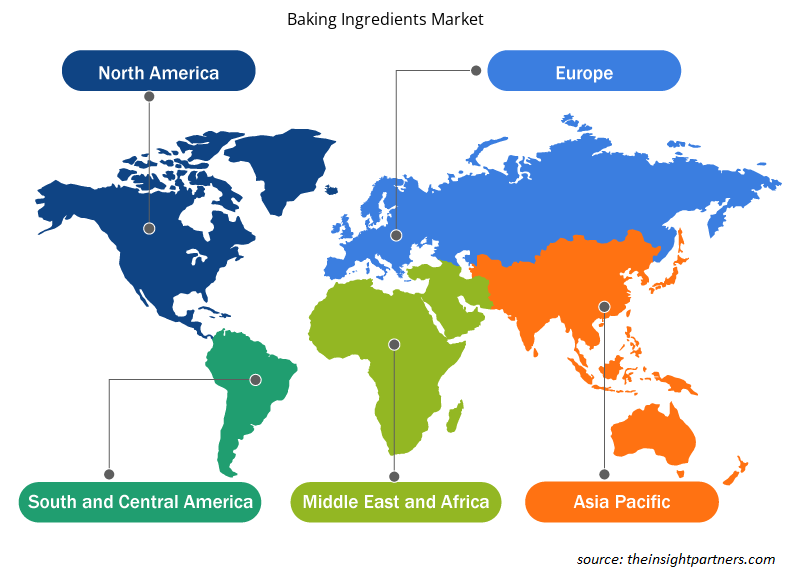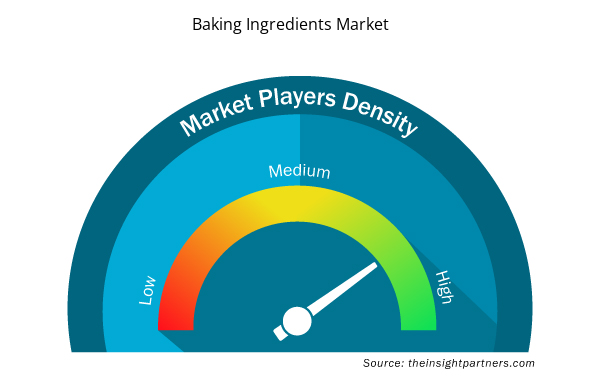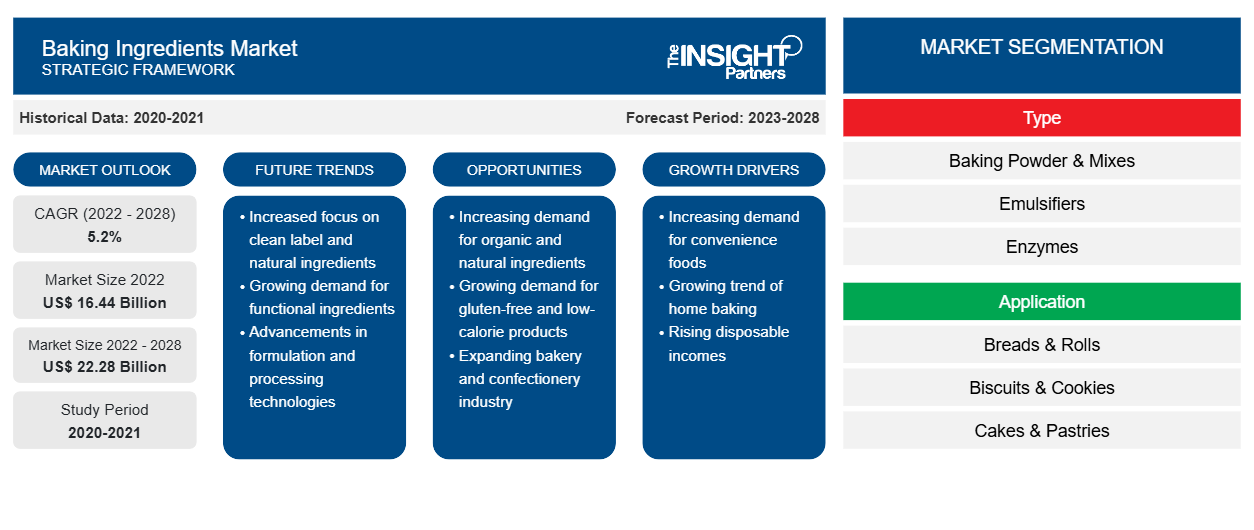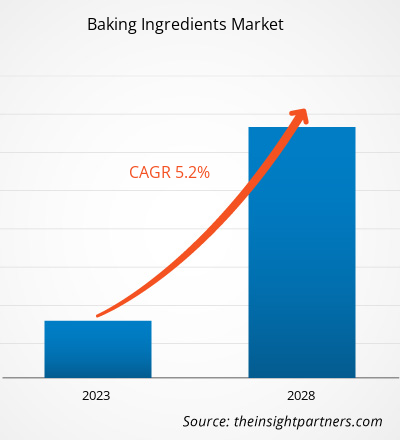Le marché des ingrédients de boulangerie devrait atteindre 22 278,10 millions USD d'ici 2028, contre 16 444,97 millions USD en 2022 ; il devrait croître à un TCAC de 5,2 % de 2022 à 2028.
Les ingrédients de boulangerie comprennent les farines et les prémélanges, les édulcorants, les agents de revitalisation, la levure, les matières grasses, les émulsifiants, les matières grasses, les enzymes, les arômes, les colorants et les inclusions. Ces ingrédients jouent un rôle spécifique dans la qualité des produits de boulangerie. Par exemple, la levure donne du volume aux aliments cuits au four et rend les produits moelleux, légers et moelleux. Les matières grasses et les matières grasses améliorent la texture et la force de la pâte. Les arômes et les colorants améliorent le goût et l'attrait visuel des produits de boulangerie . La demande croissante de produits de boulangerie, en particulier de gâteaux, de biscuits et de pâtisseries sucrées, en raison de la tendance croissante à la consommation gourmande, stimule la croissance du marché des ingrédients de boulangerie.
Le marché des ingrédients de boulangerie au Moyen-Orient et en Afrique devrait connaître la croissance la plus rapide au cours de la période de prévision. La région a connu un changement dans les conditions socio-économiques en raison de l'évolution rapide de l'économie et de l'augmentation des revenus disponibles. De plus, l'urbanisation rapide, le mode de vie moderne et les capacités de dépenses accrues ont modifié les habitudes d'achat et de consommation alimentaire des gens. L'influence croissante de la culture occidentale, en particulier parmi la population jeune, transforme les habitudes de consommation. On observe une préférence croissante pour les produits alimentaires de commodité qui sont consommés sur le pouce. La demande de produits de boulangerie augmente en raison de leur prix abordable et de leur facilité de consommation. Ces facteurs contribuent à la croissance de l'industrie de la boulangerie, stimulant ainsi la croissance du marché des ingrédients de boulangerie au Moyen-Orient et en Afrique.
Personnalisez ce rapport en fonction de vos besoins
Vous bénéficierez d'une personnalisation gratuite de n'importe quel rapport, y compris de certaines parties de ce rapport, d'une analyse au niveau des pays, d'un pack de données Excel, ainsi que de superbes offres et réductions pour les start-ups et les universités.
- Obtenez les principales tendances clés du marché de ce rapport.Cet échantillon GRATUIT comprendra une analyse de données, allant des tendances du marché aux estimations et prévisions.
Impact de la pandémie de COVID-19 sur le marché des ingrédients de boulangerie
Le secteur des aliments et des boissons a été confronté à des défis inattendus dans le contexte de la pandémie de COVID-19. Diverses restrictions imposées par les gouvernements, telles que les confinements, les arrêts de production, les interdictions de voyager et les restrictions aux frontières, ont perturbé les chaînes d'approvisionnement mondiales en 2020. Cela a entraîné une pénurie de matières premières et de main-d'œuvre, ce qui a entravé la production de divers fabricants d'aliments et de boissons à petite et grande échelle. Cependant, pendant la pandémie de COVID-19, il y a eu une demande importante de produits de boulangerie tels que des gâteaux, des biscuits et des pâtisseries de la part des personnes restées chez elles, car elles percevaient ces produits comme un bon moyen de surmonter le stress lié à la pandémie, ce qui a stimulé les ventes de produits de boulangerie et d'ingrédients de boulangerie. De plus, après le début de l'épidémie de COVID-19, les gens sont devenus plus préoccupés par leur santé et leur immunité. En conséquence, ils remplacent les produits de boulangerie conventionnels par des produits fonctionnels tels que les produits biologiques, sans gluten, sans OGM, végétaliens et enrichis. Ce facteur devrait offrir des opportunités de croissance rentables au marché des ingrédients de boulangerie pour les produits fonctionnels au cours de la période de prévision.
Perspectives du marché
La demande croissante d'ingrédients fonctionnels offre des opportunités lucratives aux acteurs du marché des ingrédients de boulangerie
Les consommateurs recherchent activement les bienfaits pour la santé des produits alimentaires qu'ils consomment. Dans le contexte de l'épidémie de COVID-19, ils sont devenus plus soucieux de leur santé et préfèrent les produits qui offrent des avantages fonctionnels. Par conséquent, ils ont tendance à remarquer la valeur nutritionnelle des produits de boulangerie, ce qui attire leur attention vers des produits contenant des ingrédients plus sains, tels que des fibres, des probiotiques, des protéines végétales et une faible teneur en sucre. De nombreux consommateurs augmentent leur consommation de fibres pour gérer leur poids et favoriser la santé digestive. Par conséquent, les fabricants de produits de boulangerie utilisent des ingrédients riches en fibres tels que les farines de grains entiers pour répondre à la demande de produits de boulangerie riches en fibres, tels que les biscuits digestifs, les biscuits riches en fibres et le pain de blé entier. En outre, la demande d'édulcorants naturels tels que le miel, le sucre de coco et le sirop d'érable a considérablement augmenté. Les édulcorants naturels ont une valeur calorique inférieure à celle du sucre de table et offrent une saveur et une texture similaires à celles des produits de boulangerie. Ainsi, la demande croissante d'ingrédients fonctionnels dans les produits de boulangerie devrait ouvrir de nouvelles opportunités sur le marché des ingrédients de boulangerie au cours de la période de prévision.
Informations sur les types
En fonction du type, le marché des ingrédients de boulangerie est classé en poudres et mélanges de boulangerie, émulsifiants, enzymes, amidons, colorants et arômes, huiles, graisses et matières grasses, et autres. Le segment des enzymes devrait enregistrer le TCAC le plus élevé au cours de la période de prévision. Les enzymes jouent un rôle essentiel dans la fabrication des produits de boulangerie. Elles augmentent la durée de conservation des produits de boulangerie, éliminant ainsi le besoin d'utiliser des conservateurs chimiques ou artificiels. Les différentes enzymes utilisées dans le secteur de la boulangerie sont l'amylase, l'oxydase et la protéase, entre autres.
Informations sur les applications
En fonction des applications, le marché des ingrédients de boulangerie est segmenté en pains et petits pains, biscuits et cookies, gâteaux et pâtisseries, etc. Le segment du pain et des petits pains représentait la plus grande part de marché en 2021. Le pain et les petits pains comprennent la baguette, le pain au levain, le pain à la levure, la brioche, la focaccia et le pain ciabatta. Les préférences des consommateurs évoluent de jour en jour et le besoin d'un produit de haute qualité propulse l'expansion du pain et des petits pains sains.
Les principaux acteurs du marché des ingrédients de boulangerie sont Cargill, Incorporated ; ADM ; Associated British Foods Plc. ; Koninklijke DSM NV ; Kerry Group Plc ; AAK AB ; British Bakels ; Corbion ; International Flavors & Fragrances Inc. ; et Dawn Food Products Inc. ; entre autres. Ces entreprises proposent un large portefeuille de produits d'ingrédients de boulangerie. Elles sont présentes dans les régions développées et en développement. Les principaux acteurs du marché se concentrent fortement sur le développement de produits de haute qualité et innovants pour répondre aux exigences des clients.
Informations régionales sur le marché des ingrédients de boulangerie
Les tendances régionales et les facteurs influençant le marché des ingrédients de boulangerie tout au long de la période de prévision ont été expliqués en détail par les analystes d’Insight Partners. Cette section traite également des segments et de la géographie du marché des ingrédients de boulangerie en Amérique du Nord, en Europe, en Asie-Pacifique, au Moyen-Orient et en Afrique, ainsi qu’en Amérique du Sud et en Amérique centrale.

- Obtenez les données régionales spécifiques au marché des ingrédients de boulangerie
Portée du rapport sur le marché des ingrédients de boulangerie
| Attribut de rapport | Détails |
|---|---|
| Taille du marché en 2022 | 16,44 milliards de dollars américains |
| Taille du marché d'ici 2028 | 22,28 milliards de dollars américains |
| Taux de croissance annuel composé mondial (2022-2028) | 5,2% |
| Données historiques | 2020-2021 |
| Période de prévision | 2023-2028 |
| Segments couverts | Par type
|
| Régions et pays couverts | Amérique du Nord
|
| Leaders du marché et profils d'entreprises clés |
|
Densité des acteurs du marché des ingrédients de boulangerie : comprendre son impact sur la dynamique commerciale
Le marché des ingrédients de boulangerie connaît une croissance rapide, tirée par la demande croissante des utilisateurs finaux en raison de facteurs tels que l'évolution des préférences des consommateurs, les avancées technologiques et une plus grande sensibilisation aux avantages du produit. À mesure que la demande augmente, les entreprises élargissent leurs offres, innovent pour répondre aux besoins des consommateurs et capitalisent sur les tendances émergentes, ce qui alimente davantage la croissance du marché.
La densité des acteurs du marché fait référence à la répartition des entreprises ou des sociétés opérant sur un marché ou un secteur particulier. Elle indique le nombre de concurrents (acteurs du marché) présents sur un marché donné par rapport à sa taille ou à sa valeur marchande totale.
Les principales entreprises opérant sur le marché des ingrédients de boulangerie sont :
- Cargill, société incorporée
- SMA
- Société d'alimentation britannique associée plc
- Royal DSM NV
- Kerry
Avis de non-responsabilité : les sociétés répertoriées ci-dessus ne sont pas classées dans un ordre particulier.

- Obtenez un aperçu des principaux acteurs du marché des ingrédients de boulangerie
Rapports en vedette
- Tendances progressistes de l'industrie sur le marché des ingrédients de boulangerie pour aider les entreprises à développer des stratégies efficaces à long terme
- Stratégies de croissance des entreprises adoptées par les acteurs du marché dans les pays développés et en développement
- Analyse quantitative du marché de 2020 à 2028
- Estimation de la demande mondiale en ingrédients de boulangerie
- Analyse des cinq forces de Porter pour illustrer l'efficacité des acheteurs et des fournisseurs sur le marché des ingrédients de boulangerie
- Développements récents pour comprendre le scénario concurrentiel du marché
- Tendances et perspectives du marché et facteurs régissant la croissance du marché des ingrédients de boulangerie
- Aide à la prise de décision en mettant en évidence les stratégies de marché qui sous-tendent l'intérêt commercial
- Taille du marché des ingrédients de boulangerie à différents niveaux
- Aperçu détaillé du marché et segmentation, et dynamique de l'industrie des ingrédients de boulangerie
- Taille du marché des ingrédients de boulangerie dans diverses régions avec des opportunités de croissance prometteuses
- Analyse historique (2 ans), année de base, prévision (7 ans) avec TCAC
- Analyse PEST et SWO
- Taille du marché Valeur / Volume - Mondial, Régional, Pays
- Industrie et paysage concurrentiel
- Ensemble de données Excel



Report Coverage
Revenue forecast, Company Analysis, Industry landscape, Growth factors, and Trends

Segment Covered
This text is related
to segments covered.

Regional Scope
North America, Europe, Asia Pacific, Middle East & Africa, South & Central America

Country Scope
This text is related
to country scope.
Questions fréquemment posées
The global bakery sector has been continuously expanding. The rise in global population, rapid urbanization, and changing consumer habits and lifestyles are shaping the global bakery sector. In recent years, people have become increasingly concerned about the ingredients used in the food products they consume. Consumer preferences are shifting toward more natural, organic, and less processed food products as they perceive these products to be healthier and of superior quality than the conventional ones. Moreover, consumers believe that organic and clean-label products provide better nutritional benefits and are more sustainable than traditional products. Hence, surging demand for organic and clean-label bakery ingredients worldwide.
Based on the application, bread & rolls segment is projected to grow at the fastest CAGR over the forecast period. As the rolls are a common breakfast & snack option in Europe, mainly in Germany, Austria, Switzerland, Sweden, and the UK & other countries with a booming bread culture. Also, bread is a staple food & it has been an essential part of many cultures' diets. Moreover, consumer preferences are changing day by day, and a need for a high-quality product propels the expansion of healthy bread & rolls. The bread & rolls are highly demanded in industrial, in-store bakeries. These factors are expected to boost the segment’s growth during the forecast period.
Asia Pacific accounted for the largest share of the global baking ingredients market. The market growth is attributed to increasing demand for bakery products such as bread, cakes, pastries, and muffins and the growing influence of western culture on the young population in the region. The bakery industry in Asia Pacific is rapidly advancing with the growing consumption of convenience food products. The rising disposable income levels of consumers and the growth of the middle-class population are among the key factors driving the demand for bakery products in the region.
Based on type, other segments mainly include various flours. Consumers are demanding whole grain flours such as wheat, oats, rye, millet, quinoa, barley, or a combination of grains, as the population is inclining toward a healthy lifestyle. The other segment also includes various types of sugars such as granulated, powdered, and brown sugar, date sugar, coconut sugar, maple sugar, honey, molasses, maple syrup, cane syrup, and agave syrup. Moreover, milk, extracts of fruits & spices, and essential add-ins such as chocolates, cocoa powder, dried fruits & nuts, coconut (shredded/flakes), matcha powders, and chia seeds. In these, segments, the manufacturer can offer products according to the customized taste, flavor & demand of the region.
The major players operating in the global baking ingredients market are Cargill, Incorporated; ADM; Associated British Foods plc; Koninklijke DSM N.V.; Kerry; AAK AB; British Bakels; Corbion; International Flavors & Fragrances; and Dawn Food Products Inc.
The importance of gut health has been increasing among people. Therefore, people include probiotics in their diet to ensure good gut health. Bakery manufacturers are also experimenting with probiotics to develop innovative products with digestive health claims. For instance, Lallemand Inc. offers active freeze-dried probiotic bacteria Bacillus subtilis Rosell-179 for baking applications. Functional ingredients are widely employed in bakery products as consumers have become health conscious. Thus, the rising demand for functional ingredients in bakery products is expected to open new opportunities in the baking ingredients market over the forecast period.
Trends and growth analysis reports related to Food and Beverages : READ MORE..
The List of Companies - Baking Ingredients Market
- Cargill, Incorporated
- ADM
- Associated British Foods plc
- Koninklijke DSM N.V.
- Kerry
- AAK AB
- British Bakels
- Corbion
- International Flavours & Fragrances
- Dawn Food Products Inc.
The Insight Partners performs research in 4 major stages: Data Collection & Secondary Research, Primary Research, Data Analysis and Data Triangulation & Final Review.
- Data Collection and Secondary Research:
As a market research and consulting firm operating from a decade, we have published and advised several client across the globe. First step for any study will start with an assessment of currently available data and insights from existing reports. Further, historical and current market information is collected from Investor Presentations, Annual Reports, SEC Filings, etc., and other information related to company’s performance and market positioning are gathered from Paid Databases (Factiva, Hoovers, and Reuters) and various other publications available in public domain.
Several associations trade associates, technical forums, institutes, societies and organization are accessed to gain technical as well as market related insights through their publications such as research papers, blogs and press releases related to the studies are referred to get cues about the market. Further, white papers, journals, magazines, and other news articles published in last 3 years are scrutinized and analyzed to understand the current market trends.
- Primary Research:
The primarily interview analysis comprise of data obtained from industry participants interview and answers to survey questions gathered by in-house primary team.
For primary research, interviews are conducted with industry experts/CEOs/Marketing Managers/VPs/Subject Matter Experts from both demand and supply side to get a 360-degree view of the market. The primary team conducts several interviews based on the complexity of the markets to understand the various market trends and dynamics which makes research more credible and precise.
A typical research interview fulfils the following functions:
- Provides first-hand information on the market size, market trends, growth trends, competitive landscape, and outlook
- Validates and strengthens in-house secondary research findings
- Develops the analysis team’s expertise and market understanding
Primary research involves email interactions and telephone interviews for each market, category, segment, and sub-segment across geographies. The participants who typically take part in such a process include, but are not limited to:
- Industry participants: VPs, business development managers, market intelligence managers and national sales managers
- Outside experts: Valuation experts, research analysts and key opinion leaders specializing in the electronics and semiconductor industry.
Below is the breakup of our primary respondents by company, designation, and region:

Once we receive the confirmation from primary research sources or primary respondents, we finalize the base year market estimation and forecast the data as per the macroeconomic and microeconomic factors assessed during data collection.
- Data Analysis:
Once data is validated through both secondary as well as primary respondents, we finalize the market estimations by hypothesis formulation and factor analysis at regional and country level.
- Macro-Economic Factor Analysis:
We analyse macroeconomic indicators such the gross domestic product (GDP), increase in the demand for goods and services across industries, technological advancement, regional economic growth, governmental policies, the influence of COVID-19, PEST analysis, and other aspects. This analysis aids in setting benchmarks for various nations/regions and approximating market splits. Additionally, the general trend of the aforementioned components aid in determining the market's development possibilities.
- Country Level Data:
Various factors that are especially aligned to the country are taken into account to determine the market size for a certain area and country, including the presence of vendors, such as headquarters and offices, the country's GDP, demand patterns, and industry growth. To comprehend the market dynamics for the nation, a number of growth variables, inhibitors, application areas, and current market trends are researched. The aforementioned elements aid in determining the country's overall market's growth potential.
- Company Profile:
The “Table of Contents” is formulated by listing and analyzing more than 25 - 30 companies operating in the market ecosystem across geographies. However, we profile only 10 companies as a standard practice in our syndicate reports. These 10 companies comprise leading, emerging, and regional players. Nonetheless, our analysis is not restricted to the 10 listed companies, we also analyze other companies present in the market to develop a holistic view and understand the prevailing trends. The “Company Profiles” section in the report covers key facts, business description, products & services, financial information, SWOT analysis, and key developments. The financial information presented is extracted from the annual reports and official documents of the publicly listed companies. Upon collecting the information for the sections of respective companies, we verify them via various primary sources and then compile the data in respective company profiles. The company level information helps us in deriving the base number as well as in forecasting the market size.
- Developing Base Number:
Aggregation of sales statistics (2020-2022) and macro-economic factor, and other secondary and primary research insights are utilized to arrive at base number and related market shares for 2022. The data gaps are identified in this step and relevant market data is analyzed, collected from paid primary interviews or databases. On finalizing the base year market size, forecasts are developed on the basis of macro-economic, industry and market growth factors and company level analysis.
- Data Triangulation and Final Review:
The market findings and base year market size calculations are validated from supply as well as demand side. Demand side validations are based on macro-economic factor analysis and benchmarks for respective regions and countries. In case of supply side validations, revenues of major companies are estimated (in case not available) based on industry benchmark, approximate number of employees, product portfolio, and primary interviews revenues are gathered. Further revenue from target product/service segment is assessed to avoid overshooting of market statistics. In case of heavy deviations between supply and demand side values, all thes steps are repeated to achieve synchronization.
We follow an iterative model, wherein we share our research findings with Subject Matter Experts (SME’s) and Key Opinion Leaders (KOLs) until consensus view of the market is not formulated – this model negates any drastic deviation in the opinions of experts. Only validated and universally acceptable research findings are quoted in our reports.
We have important check points that we use to validate our research findings – which we call – data triangulation, where we validate the information, we generate from secondary sources with primary interviews and then we re-validate with our internal data bases and Subject matter experts. This comprehensive model enables us to deliver high quality, reliable data in shortest possible time.


 Obtenez un échantillon gratuit pour ce rapport
Obtenez un échantillon gratuit pour ce rapport